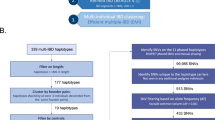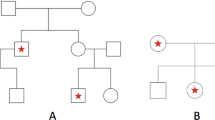Abstract
Several lines of evidence suggest a role for SNAP-25 (synaptosomal-associated protein of 25 kDa) in the genetic aetiology of ADHD. Most notable is the coloboma mouse mutant, which displays spontaneous hyperactivity and is hemizygous for a deletion spanning this gene. We have screened the SNAP-25 gene using denaturing high-performance liquid chromatography and sequencing, and genotyped six polymorphic single-nucleotide polymorphisms and two microsatellites in a clinically ascertained sample of 188 probands. Several markers were found to show association with ADHD, both individually and in combination with other markers to form multimarker haplotypes. Analyses of transmission by parental sex suggested that the association of SNAP-25 with ADHD is largely due to transmission of alleles from paternal chromosomes to affected probands, suggesting that this locus may be subject to genomic imprinting. Overall our data provide some evidence for a role of this gene in ADHD, although the precise causal functional variant is yet to be ascertained.
This is a preview of subscription content, access via your institution
Access options
Subscribe to this journal
Receive 12 print issues and online access
$259.00 per year
only $21.58 per issue
Buy this article
- Purchase on Springer Link
- Instant access to full article PDF
Prices may be subject to local taxes which are calculated during checkout



Similar content being viewed by others
References
Oyler GA, Higgins GA, Hart RA, Battenberg E, Billingsley M, Bloom FE et al. The identification of a novel synaptosomal-associated protein, SNAP-25, differentially expressed by neuronal subpopulations. J Cell Biol 1989; 109(Part 1): 3039–3052.
Osen-Sand A, Catsicas M, Staple JK, Jones KA, Ayala G, Knowles J et al. Inhibition of axonal growth by SNAP-25 antisense oligonucleotides in vitro and in vivo. Nature 1993; 364: 445–448.
Hess EJ, Collins KA, Wilson MC . Mouse model of hyperkinesis implicates SNAP-25 in behavioral regulation. J Neurosci 1996; 16: 3104–3111.
Hess EJ, Jinnah HA, Kozak CA, Wilson MC . Spontaneous locomotor hyperactivity in a mouse mutant with a deletion including the Snap gene on chromosome 2. J Neurosci 1992; 12: 2865–2874.
Jones MD, Williams ME, Hess EJ . Abnormal presynaptic catecholamine regulation in a hyperactive SNAP-25-deficient mouse mutant. Pharmacol Biochem Behav 2001; 68: 669–676.
Hess EJ, Rogan PK, Domoto M, Tinker DE, Ladda RL, Ramer JC . Absence of linkage of apparently single gene mediated ADHD with the human syntenic region of the mouse mutant Coloboma. Am J Med Genet 1995; 60: 573–579.
Mill J, Curran S, Kent L, Gould A, Huckett L, Richards S et al. Association study of a SNAP-25 microsatellite and attention deficit hyperactivity disorder. Am J Med Genet 2002; 114: 269–271.
Barr CL, Feng Y, Wigg K, Bloom S, Roberts W, Malone M et al. Identification of DNA variants in the SNAP-25 gene and linkage study of these polymorphisms and attention-deficit hyperactivity disorder. Mol Psychiatry 2000; 5: 405–409.
Kustanovich V, Merriman B, McGough J, McCracken JT, Smalley SL, Nelson SF . Biased paternal transmission of SNAP-25 risk alleles in attention-deficit hyperactivity disorder. Mol Psychiatry 2003; 8: 309–315.
Brophy K, Hawi Z, Kirley A, Fitzgerald M, Gill M . Synaptosomal-associated protein 25 (SNAP-25) and attention deficit hyperactivity disorder (ADHD): evidence of linkage and association in the Irish population. Mol Psychiatry 2002; 7: 913–917.
Risch N, Merikangas K . The future of genetic studies of complex human diseases. Science 1996; 273: 1516–1517.
Cargill M, Altshuler D, Ireland J, Sklar P, Ardlie K, Patil N et al. Characterization of single-nucleotide polymorphisms in coding regions of human genes. Nat Genet 1999; 22: 231–238.
Halushka MK, Fan JB, Bentley K, Hsie L, Shen N, Weder A et al. Patterns of single-nucleotide polymorphisms in candidate genes for blood-pressure homeostasis. Nat Genet 1999; 22: 239–247.
Freeman B, Smith N, Curtis C, Huckett L, Mill J, Craig IW . DNA from buccal swabs recruited by mail: evaluation of storage effects on long-term stability and suitability for multiplex polymerase chain reaction genotyping. Behav Genet 2003; 33: 67–72.
Angold A, Prendergast M, Cox A, Harrington R, Simonoff E, Rutter M . The Child and Adolescent Psychiatric Assessment (CAPA). Psychol Med 1995; 25: 739–753.
Conners CK . The Conners Rating Scales: Instruments for Assessments of Childhood Psychopathology. Duke University: Durham, 1995.
Curran S, Newman S, Taylor E, Asherson P . Hypescheme: an operational criteria checklist and minimum data set for molecular genetic studies of attention deficit and hyperactivity disorders. Am J Med Genet 2000; 96: 244–250.
Sham PC, Curtis D . An extended transmission/disequilibrium test (TDT) for multi-allele marker loci. Ann Hum Genet 1995; 59(Part 3): 323–336.
Terwilliger JD, Ott J . A haplotype-based ‘haplotype relative risk’ approach to detecting allelic associations. Hum Hered 1992; 42: 337–346.
Martin ER, Monks SA, Warren LL, Kaplan NL . A test for linkage and association in general pedigrees: the pedigree disequilibrium test. Am J Hum Genet 2000; 67: 146–154.
Acknowledgements
This research was funded by a Medical Research Council (MRC) component grant to the Social Genetic Developmental Psychiatry Research Centre. Jonathan Mill is an MRC PhD student. We thank Dr Margaret Thompson, Dr Ann York, Dr Quentin Spender, Dr Saama El Abd, Dr Mark Berlowitz, Dr Fiona McNicholas, Dr Mary Cameron, Jonathan Sharp, Claire Batten, and Shamira Fernando for their assistance in recruiting the clinical sample.
Author information
Authors and Affiliations
Corresponding author
Rights and permissions
About this article
Cite this article
Mill, J., Richards, S., Knight, J. et al. Haplotype analysis of SNAP-25 suggests a role in the aetiology of ADHD. Mol Psychiatry 9, 801–810 (2004). https://doi.org/10.1038/sj.mp.4001482
Received:
Revised:
Accepted:
Published:
Issue Date:
DOI: https://doi.org/10.1038/sj.mp.4001482
Keywords
This article is cited by
-
ADHS im Kindes- und Jugendalter. Update 2020
Pädiatrie & Pädologie (2020)
-
The Association of SNAP25 Gene Polymorphisms in Attention Deficit/Hyperactivity Disorder: a Systematic Review and Meta-Analysis
Molecular Neurobiology (2017)
-
SNARE complex in developmental psychiatry: neurotransmitter exocytosis and beyond
Journal of Neural Transmission (2016)
-
Expanding the toolbox of ADHD genetics. How can we make sense of parent of origin effects in ADHD and related behavioral phenotypes?
Behavioral and Brain Functions (2015)
-
Synaptosomal-associated protein 25 mutation induces immaturity of the dentate granule cells of adult mice
Molecular Brain (2013)



